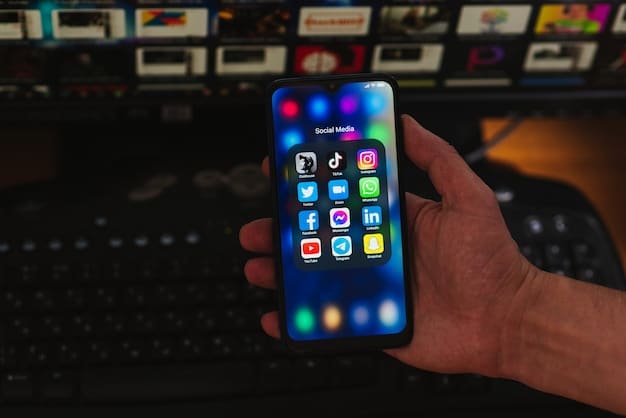Streaming and Data Usage: Tips to Minimize Consumption in Brazil

Streaming and data usage can be a concern in Brazil due to internet costs. Minimizing your internet consumption while streaming involves adjusting video quality, utilizing Wi-Fi, downloading content for offline viewing, and monitoring data usage.
In Brazil, enjoying your favorite streaming content doesn’t have to mean exceeding your data limits. With rising internet costs, many Brazilians are looking for ways to minimize **streaming and data usage**. By understanding how streaming platforms consume data and adopting simple strategies, you can enjoy uninterrupted entertainment without breaking the bank.
Understanding Streaming and Data Usage in Brazil
In Brazil, the digital landscape presents both opportunities and challenges. While streaming services offer a vast array of content, data costs and limitations can be a significant concern for many users.
Understanding the dynamics of data consumption is the first step toward effectively managing your internet usage. This knowledge empowers you to make informed decisions about your streaming habits.

How Much Data Does Streaming Actually Use?
The amount of data consumed by streaming services varies widely depending on video quality. Standard definition (SD) video consumes less data than high definition (HD) or ultra-high definition (UHD) content. Audio quality also plays a role, with higher bitrates requiring more data.
Consider these average data consumption rates:
- SD video: Approximately 0.7GB per hour
- HD video: Approximately 3GB per hour
- UHD video: Approximately 7GB per hour
- High-quality audio: Approximately 150MB per hour
These figures highlight the importance of being mindful of the quality settings you choose. Adjusting these settings can significantly impact your overall data usage.
Factors Affecting Data Consumption
Several factors can influence how much data you use while streaming. The type of content you’re watching, the streaming platform you’re using, and your device all play a role.
- Video Quality: Higher resolution videos consume significantly more data.
- Streaming Platform: Different platforms use different compression algorithms.
- Device: Some devices are more efficient at data usage than others.
Understanding these factors allows you to tailor your streaming habits to your data plan, ultimately lowering data consumption.
Ultimately, understanding how streaming works is key if you want to leverage techniques for **Streaming and Data Usage: How to Minimize Your Internet Consumption in Brazil**. By knowing the basics, you will have better chances of keeping up with your favorite content without surprises on your internet bill.
Adjusting Video Quality for Data Efficiency
One of the most effective ways to minimize your data consumption while streaming is by adjusting the video quality settings. Lowering the resolution can significantly reduce the amount of data used without drastically impacting your viewing experience.
Streaming platforms like Netflix, YouTube, and Amazon Prime Video provide options to manually adjust video quality or set it to “auto,” which adapts to your internet speed.
How to Change Video Quality Settings
Most streaming platforms offer intuitive interfaces to adjust video quality. On Netflix, for example, you can go to your account settings and select a lower data usage option. Similar settings can be found on YouTube and other platforms.
Here’s how to typically find these settings:
- Netflix: Account > Profile > Playback settings
- YouTube: Video settings > Quality
- Amazon Prime Video: Settings > Stream & Download > Streaming Quality
By familiarizing yourself with these settings, you can quickly adapt your streaming preferences to save data whenever necessary.
Balancing Quality and Data Usage
Finding the right balance between video quality and data usage is essential. While lower resolutions save data, they may also reduce the viewing experience you want.
- Experiment with different resolutions.
- Consider the screen size of your device.
- Adjust settings based on content type.
By understanding your needs, you can prioritize what matters most to you, and ultimately optimize your data consumption.
By lowering the resolution, it is possible to experience the benefits of **Streaming and Data Usage: How to Minimize Your Internet Consumption in Brazil** for your budget.
Leveraging Wi-Fi Networks to Reduce Mobile Data Usage
Wi-Fi networks provide an opportunity to stream content without using your mobile data allowance. Whenever possible, connecting to a Wi-Fi network can significantly reduce your reliance on mobile data.
This approach is particularly useful in Brazil, where Wi-Fi is often available in public spaces, cafes, and homes. It also helps when planning for trips, and allows for mobile data conservation.
Finding and Connecting to Wi-Fi Networks
Identifying and connecting to available Wi-Fi networks is straightforward. Most smartphones and devices automatically scan for nearby networks. When choosing a network, prioritize secure, password-protected connections to protect your privacy.
Here are some simple tips:
- Check for Wi-Fi symbols on your device.
- Use password-protected networks.
- Be cautious with public Wi-Fi hotspots.
Adopting these habits can help you maximize your connectivity while minimizing data risks.
Optimizing Wi-Fi Usage for Streaming
To make the most of Wi-Fi usage for streaming, consider a few best practices. Ensure your Wi-Fi signal is strong and stable. Limit other devices using the network simultaneously to maintain optimal streaming speeds. Streaming while connected to Wi-Fi can considerably benefit **Streaming and Data Usage: How to Minimize Your Internet Consumption in Brazil**.
- Ensure a strong Wi-Fi signal.
- Limit simultaneous devices on the network.
- Use a Wi-Fi analyzer app.
These small adjustments can lead to a smoother streaming experience without unexpected data usage issues.
Using Wi-fi is a simple yet essential method to save bandwidth and reduce the pressure on your mobile data when it comes to **Streaming and Data Usage: How to Minimize Your Internet Consumption in Brazil**.

Downloading Content for Offline Viewing
Many streaming services offer the option to download content for offline viewing. This feature allows you to download movies, TV shows, and music over Wi-Fi and watch them later without using any mobile data. Downloading media beforehand contributes to **Streaming and Data Usage: How to Minimize Your Internet Consumption in Brazil**.
Being strategic about downloading can greatly reduce your data consumption, especially when you know you’ll be in an area with limited or no internet access, such as during a commute or while traveling.
How to Download Content on Streaming Platforms
Downloading content is generally a simple process on most major streaming platforms. Look for the download icon (usually a downward-pointing arrow) on the video or audio you want to save. Keep in mind that downloaded content may have an expiration date.
Here’s how to download on popular platforms:
- Netflix: Look for the download icon next to episodes or movies.
- Spotify: Toggle the “Download” switch for albums and playlists.
- Amazon Prime Video: Select the download option on the video details page.
By understanding these steps, you can effortlessly build a library of offline content and save data.
Managing Downloaded Content
Effective management of downloaded content is crucial to avoid filling up your device’s storage. Regularly review your downloaded content and delete any items you no longer need. Keep an eye on the storage space being used by your streaming apps.
- Regularly delete watched content.
- Check storage space in app settings.
- Use external storage if available.
By managing your downloads, you can optimize your device’s storage and continue to enjoy offline content efficiently.
The concept of downloading is a great plan for those interested in **Streaming and Data Usage: How to Minimize Your Internet Consumption in Brazil**, because it allows users to see their favorite content without actively using mobile data.
Monitoring Your Data Usage Effectively
Keeping track of your data usage is crucial for staying within your data limits. Most smartphones offer built-in tools to monitor data consumption. Additionally, many mobile providers offer apps that provide detailed insights into your data usage patterns.
Proactive monitoring is essential for avoiding unexpected charges and adapting your streaming habits.
Using Built-in Data Monitoring Tools
Most smartphones have integrated data monitoring features. On Android devices, you can find these settings under “Data Usage” in the settings menu. On iOS devices, go to “Cellular” to view your data usage statistics. These tools allow you to see which apps are consuming the most data.
Here’s how to monitor data usage:
- Android: Settings > Data Usage
- iOS: Settings > Cellular
By regularly checking these settings, you can identify data-hungry apps and take necessary actions.
Setting Data Usage Alerts and Limits
To avoid exceeding your data limits, set up data usage alerts and limits on your smartphone. Both Android and iOS offer options to alert you when you approach your data cap and automatically disable mobile data when you reach your limit. This is a good method for controlling **Streaming and Data Usage: How to Minimize Your Internet Consumption in Brazil**.
- Set alerts before your data cap.
- Enable automatic data disabling.
- Review alerts frequently.
These alerts and limits can help you stay informed and prevent unexpected data charges.
Actively keeping data usage in check is an approach to **Streaming and Data Usage: How to Minimize Your Internet Consumption in Brazil** that will yield benefits for the end user.
| Key Point | Brief Description |
|---|---|
| 📱 Adjust Video Quality | Lower the resolution to reduce data consumption. |
| 🌐 Utilize Wi-Fi | Connect to Wi-Fi networks to avoid using mobile data. |
| ⬇️ Download Content | Download videos and music for offline viewing to conserve data. |
| 📊 Monitor Data Usage | Track your data consumption to stay within your limits. |
Frequently Asked Questions
Higher video quality (HD, UHD) consumes significantly more data than standard definition (SD). Lowering the resolution to SD can greatly reduce data usage for those concerned with **Streaming and Data Usage: How to Minimize Your Internet Consumption in Brazil**.
Not all streaming platforms offer download options for all content. Check the platform’s policies to see if content is available for offline viewing. This option helps you leverage **Streaming and Data Usage: How to Minimize Your Internet Consumption in Brazil**.
Ensure a strong and stable Wi-Fi signal, limit the number of devices using the network simultaneously, and consider using a Wi-Fi analyzer app to find the best channel that optimizes **Streaming and Data Usage: How to Minimize Your Internet Consumption in Brazil**.
Smartphones offer native data monitoring tools in the settings. On Android, go to “Data Usage.” On iOS, check “Cellular.” These tools show data consumption by app, helping you manage **streaming and data usage**.
Lower your video quality to save data. Connect to Wi-Fi if available. Consider downloading content over Wi-Fi or monitoring in real time to maintain **Streaming and Data Usage: How to Minimize Your Internet Consumption in Brazil** thresholds, if possible.
Conclusion
Minimizing **streaming and data usage** in Brazil is achievable by adopting simple strategies such as adjusting video quality, utilizing Wi-Fi, downloading content, and monitoring data consumption. Brazilians can enjoy streaming entertainment without straining their data limits by applying these insights, which will also help with money and budget control.
By following these tips, you can optimize your streaming experience while efficiently managing your data usage, making entertainment more affordable and accessible.





